Abstract
Bioinformatics studies two important information flows in modern biology. The first is the flow of genetic information from the DNA of an individual organism up to the characteristics of a population of such organisms (with an eventual passage of information back to the genetic pool, as encoded within DNA). The second is the flow of experimental information from observed biological phenomena to models that explain them, and then to new experiments in order to test these models. The discipline of bioinformatics has its roots in a number of activities, including the organization of DNA sequence and protein three-dimensional structural data collections in the 1960's and 1970's. It has become a booming academic and industrial enterprise with the introduction of biological experiments that rapidly produce massive amounts of data (such as the multiple genome sequencing projects, the large scale analysis of gene expression, and the large scale analysis of protein-protein interactions). Basic biological science has always had an impact on clinical medicine (and clinical medical information systems), and is creating a new generation of epidemiologic, diagnostic, prognostic, and treatment modalities. Bioinformatics efforts that appear to be wholly geared towards basic science are likely to become relevant to clinical informatics in the coming decade. For example, DNA sequence information and sequence annotations will appear in the medical chart with increasing frequency. The algorithms developed for research in bioinformatics will soon become part of clinical information systems.
Full text
PDF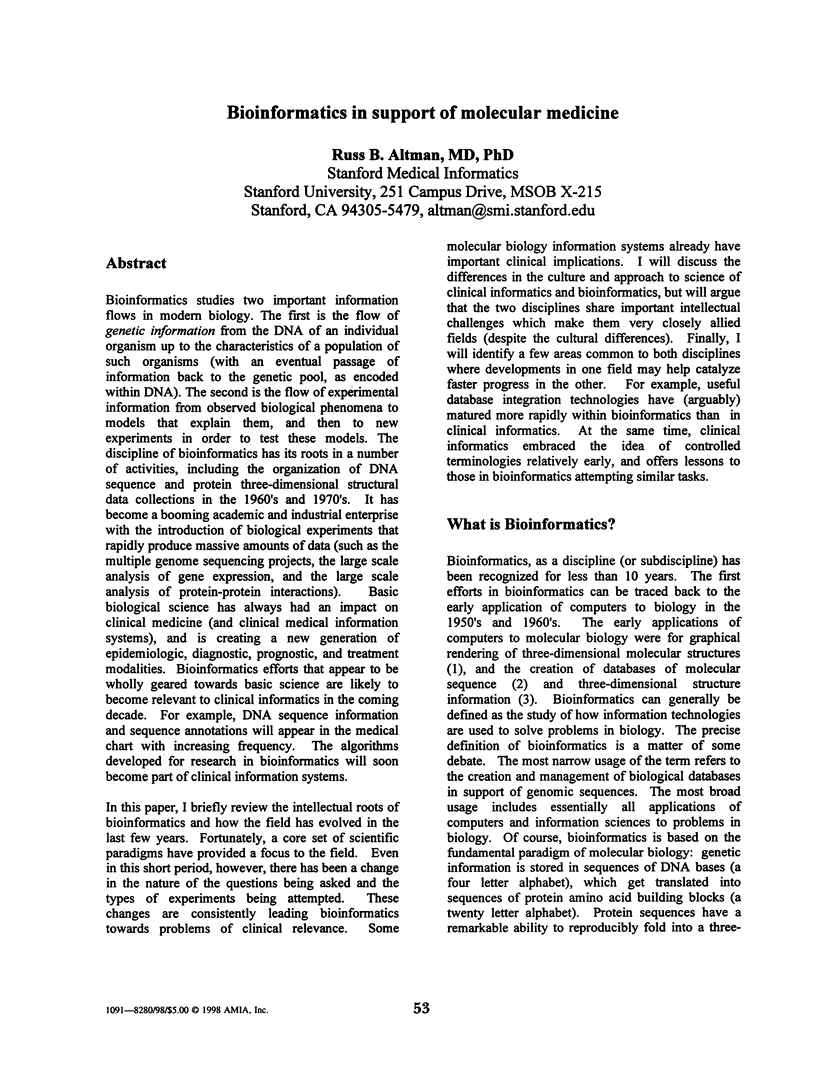
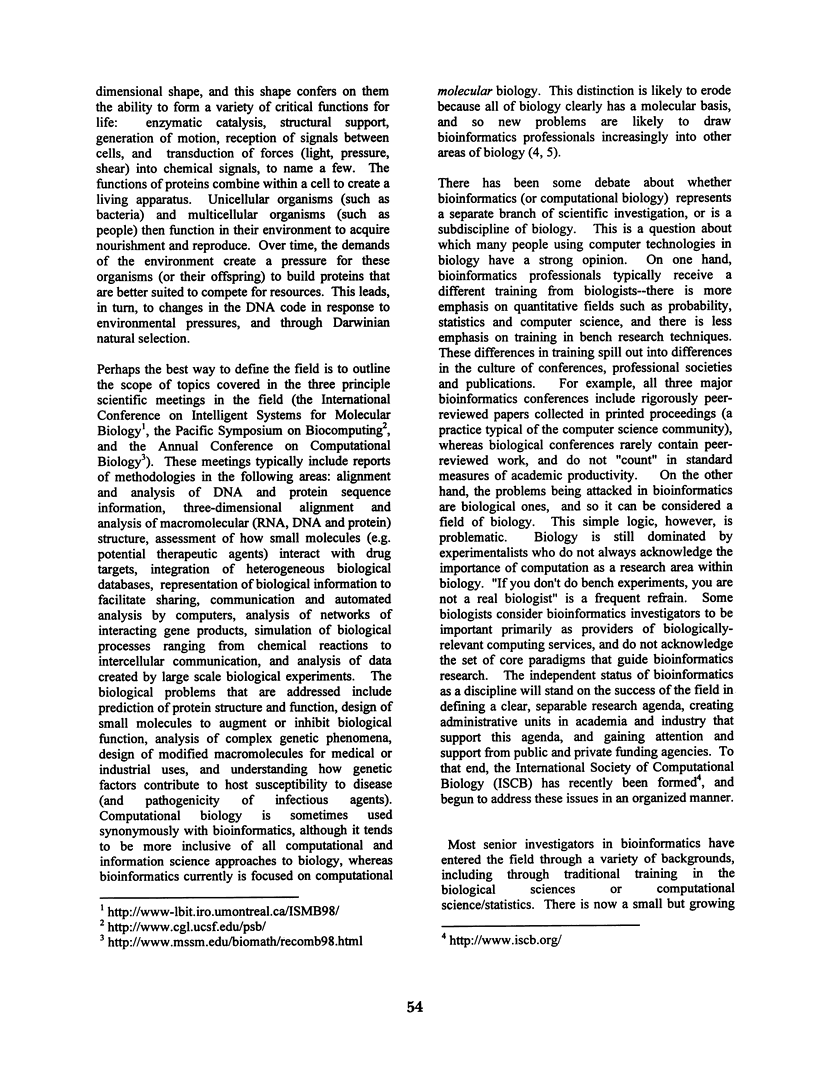
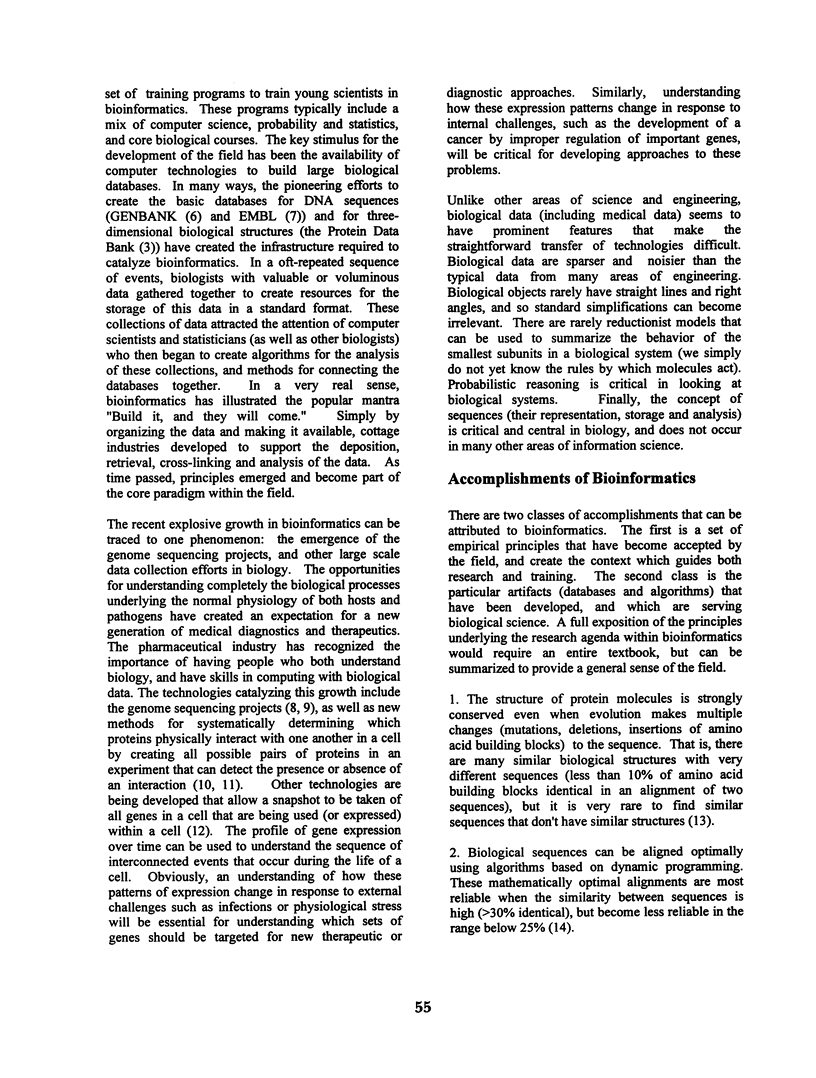
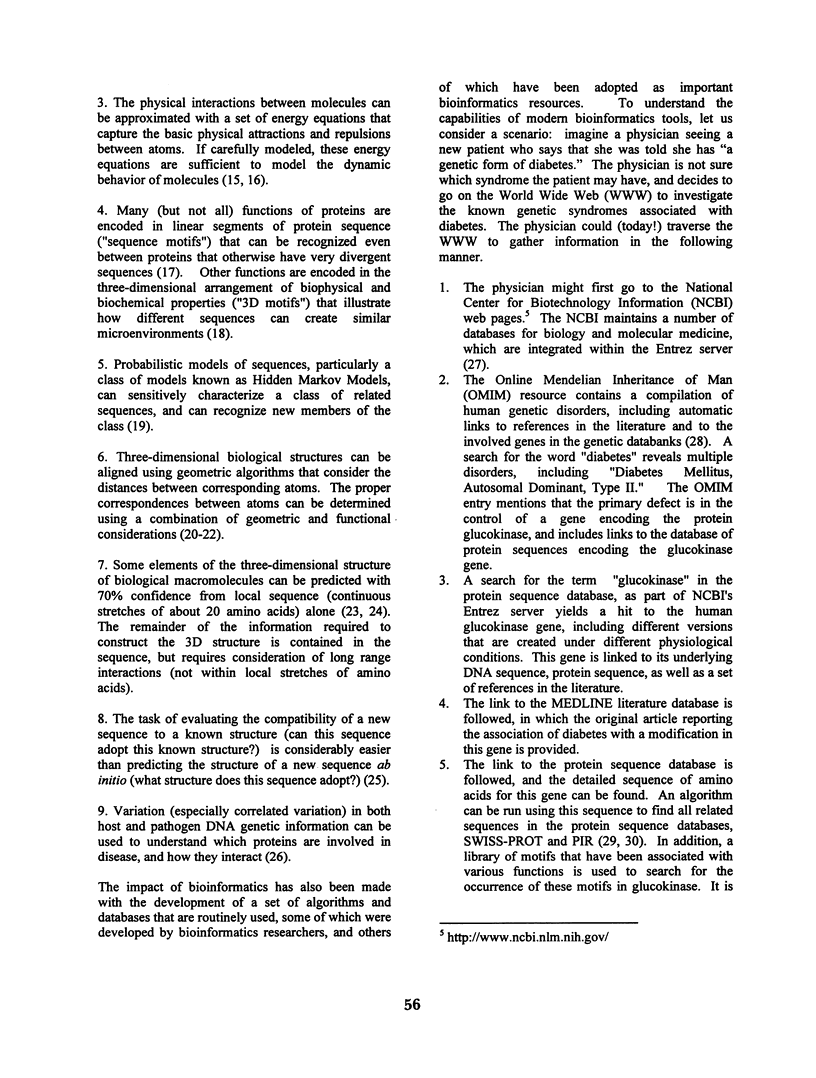
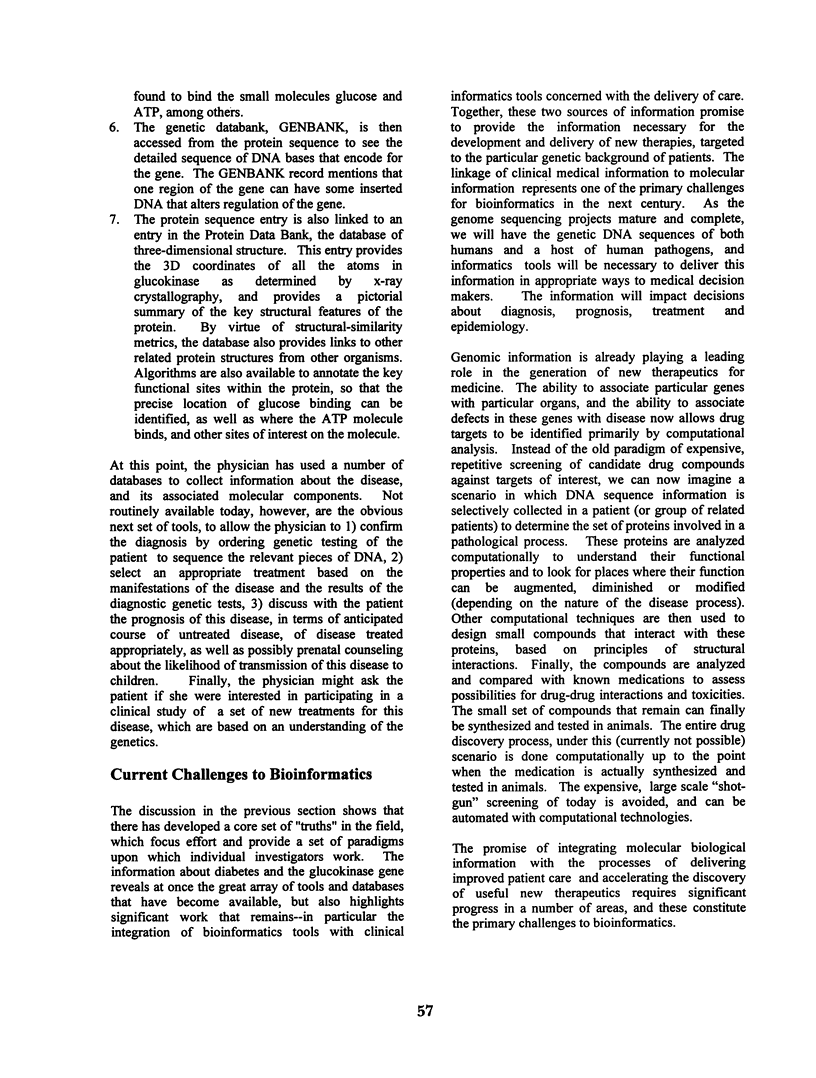
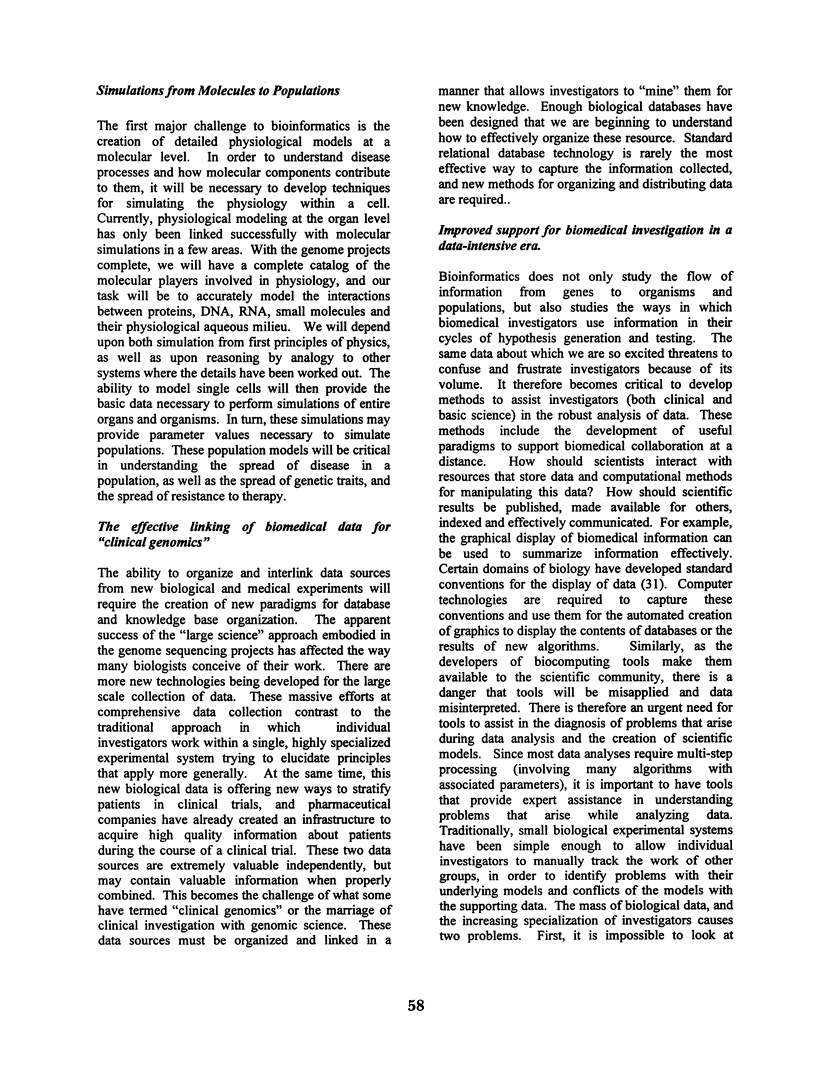
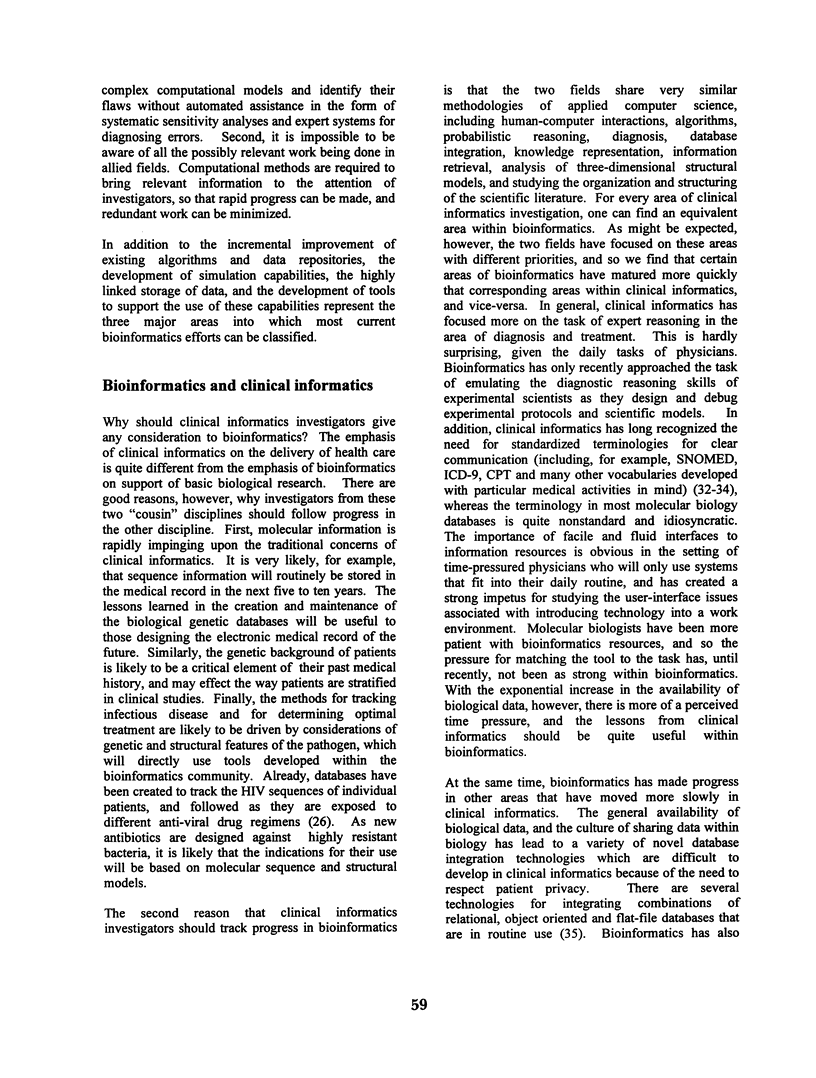

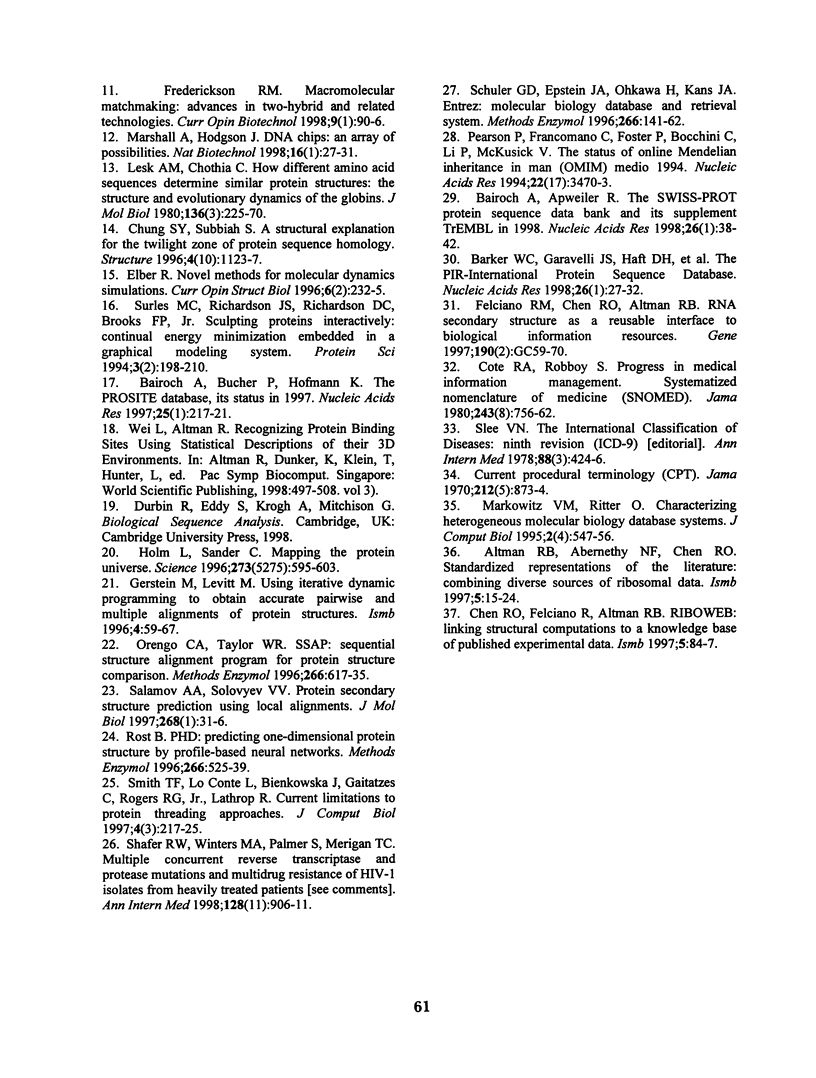
Selected References
These references are in PubMed. This may not be the complete list of references from this article.
- Altman R. B., Abernethy N. F., Chen R. O. Standardized representations of the literature: combining diverse sources of ribosomal data. Proc Int Conf Intell Syst Mol Biol. 1997;5:15–24. [PubMed] [Google Scholar]
- Bairoch A., Apweiler R. The SWISS-PROT protein sequence data bank and its supplement TrEMBL in 1998. Nucleic Acids Res. 1998 Jan 1;26(1):38–42. doi: 10.1093/nar/26.1.38. [DOI] [PMC free article] [PubMed] [Google Scholar]
- Bairoch A., Bucher P., Hofmann K. The PROSITE database, its status in 1997. Nucleic Acids Res. 1997 Jan 1;25(1):217–221. doi: 10.1093/nar/25.1.217. [DOI] [PMC free article] [PubMed] [Google Scholar]
- Barker W. C., Garavelli J. S., Haft D. H., Hunt L. T., Marzec C. R., Orcutt B. C., Srinivasarao G. Y., Yeh L. S., Ledley R. S., Mewes H. W. The PIR-International Protein Sequence Database. Nucleic Acids Res. 1998 Jan 1;26(1):27–32. doi: 10.1093/nar/26.1.27. [DOI] [PMC free article] [PubMed] [Google Scholar]
- Benson D. A., Boguski M. S., Lipman D. J., Ostell J., Ouellette B. F. GenBank. Nucleic Acids Res. 1998 Jan 1;26(1):1–7. doi: 10.1093/nar/26.1.1. [DOI] [PMC free article] [PubMed] [Google Scholar]
- Bernstein F. C., Koetzle T. F., Williams G. J., Meyer E. F., Jr, Brice M. D., Rodgers J. R., Kennard O., Shimanouchi T., Tasumi M. The Protein Data Bank: a computer-based archival file for macromolecular structures. J Mol Biol. 1977 May 25;112(3):535–542. doi: 10.1016/s0022-2836(77)80200-3. [DOI] [PubMed] [Google Scholar]
- Cantor C. R. How will the Human Genome Project improve our quality of life? Nat Biotechnol. 1998 Mar;16(3):212–213. doi: 10.1038/nbt0398-212. [DOI] [PubMed] [Google Scholar]
- Chen R. O., Felciano R., Altman R. B. RIBOWEB: linking structural computations to a knowledge base of published experimental data. Proc Int Conf Intell Syst Mol Biol. 1997;5:84–87. [PubMed] [Google Scholar]
- Chung S. Y., Subbiah S. A structural explanation for the twilight zone of protein sequence homology. Structure. 1996 Oct 15;4(10):1123–1127. doi: 10.1016/s0969-2126(96)00119-0. [DOI] [PubMed] [Google Scholar]
- Côté R. A., Robboy S. Progress in medical information management. Systematized nomenclature of medicine (SNOMED). JAMA. 1980 Feb 22;243(8):756–762. doi: 10.1001/jama.1980.03300340032015. [DOI] [PubMed] [Google Scholar]
- Elber R. Novel methods for molecular dynamics simulations. Curr Opin Struct Biol. 1996 Apr;6(2):232–235. doi: 10.1016/s0959-440x(96)80080-7. [DOI] [PubMed] [Google Scholar]
- Frederickson R. M. Macromolecular matchmaking: advances in two-hybrid and related technologies. Curr Opin Biotechnol. 1998 Feb;9(1):90–96. doi: 10.1016/s0958-1669(98)80090-6. [DOI] [PubMed] [Google Scholar]
- Gerstein M., Levitt M. Using iterative dynamic programming to obtain accurate pairwise and multiple alignments of protein structures. Proc Int Conf Intell Syst Mol Biol. 1996;4:59–67. [PubMed] [Google Scholar]
- Green P. Human Genome Project: data quality. Science. 1998 Feb 20;279(5354):1115–1116. doi: 10.1126/science.279.5354.1113f. [DOI] [PubMed] [Google Scholar]
- Holm L., Sander C. Mapping the protein universe. Science. 1996 Aug 2;273(5275):595–603. doi: 10.1126/science.273.5275.595. [DOI] [PubMed] [Google Scholar]
- Langridge R. Interactive three-dimensional computer graphics in molecular biology. Fed Proc. 1974 Dec;33(12):2332–2335. [PubMed] [Google Scholar]
- Lesk A. M., Chothia C. How different amino acid sequences determine similar protein structures: the structure and evolutionary dynamics of the globins. J Mol Biol. 1980 Jan 25;136(3):225–270. doi: 10.1016/0022-2836(80)90373-3. [DOI] [PubMed] [Google Scholar]
- Markowitz V. M., Ritter O. Characterizing heterogeneous molecular biology database systems. J Comput Biol. 1995 Winter;2(4):547–556. doi: 10.1089/cmb.1995.2.547. [DOI] [PubMed] [Google Scholar]
- Marshall A., Hodgson J. DNA chips: an array of possibilities. Nat Biotechnol. 1998 Jan;16(1):27–31. doi: 10.1038/nbt0198-27. [DOI] [PubMed] [Google Scholar]
- Orengo C. A., Taylor W. R. SSAP: sequential structure alignment program for protein structure comparison. Methods Enzymol. 1996;266:617–635. doi: 10.1016/s0076-6879(96)66038-8. [DOI] [PubMed] [Google Scholar]
- Pearson P., Francomano C., Foster P., Bocchini C., Li P., McKusick V. The status of online Mendelian inheritance in man (OMIM) medio 1994. Nucleic Acids Res. 1994 Sep;22(17):3470–3473. doi: 10.1093/nar/22.17.3470. [DOI] [PMC free article] [PubMed] [Google Scholar]
- Rost B. PHD: predicting one-dimensional protein structure by profile-based neural networks. Methods Enzymol. 1996;266:525–539. doi: 10.1016/s0076-6879(96)66033-9. [DOI] [PubMed] [Google Scholar]
- Salamov A. A., Solovyev V. V. Protein secondary structure prediction using local alignments. J Mol Biol. 1997 Apr 25;268(1):31–36. doi: 10.1006/jmbi.1997.0958. [DOI] [PubMed] [Google Scholar]
- Schuler G. D., Epstein J. A., Ohkawa H., Kans J. A. Entrez: molecular biology database and retrieval system. Methods Enzymol. 1996;266:141–162. doi: 10.1016/s0076-6879(96)66012-1. [DOI] [PubMed] [Google Scholar]
- Shafer R. W., Winters M. A., Palmer S., Merigan T. C. Multiple concurrent reverse transcriptase and protease mutations and multidrug resistance of HIV-1 isolates from heavily treated patients. Ann Intern Med. 1998 Jun 1;128(11):906–911. doi: 10.7326/0003-4819-128-11-199806010-00008. [DOI] [PubMed] [Google Scholar]
- Slee V. N. The International Classification of Diseases: ninth revision (ICD-9) Ann Intern Med. 1978 Mar;88(3):424–426. doi: 10.7326/0003-4819-88-3-424. [DOI] [PubMed] [Google Scholar]
- Smith T. F., Lo Conte L., Bienkowska J., Gaitatzes C., Rogers R. G., Jr, Lathrop R. Current limitations to protein threading approaches. J Comput Biol. 1997 Fall;4(3):217–225. doi: 10.1089/cmb.1997.4.217. [DOI] [PubMed] [Google Scholar]
- Smith T. F. The history of the genetic sequence databases. Genomics. 1990 Apr;6(4):701–707. doi: 10.1016/0888-7543(90)90509-s. [DOI] [PubMed] [Google Scholar]
- Stoesser G., Moseley M. A., Sleep J., McGowran M., Garcia-Pastor M., Sterk P. The EMBL nucleotide sequence database. Nucleic Acids Res. 1998 Jan 1;26(1):8–15. doi: 10.1093/nar/26.1.8. [DOI] [PMC free article] [PubMed] [Google Scholar]
- Surles M. C., Richardson J. S., Richardson D. C., Brooks F. P., Jr Sculpting proteins interactively: continual energy minimization embedded in a graphical modeling system. Protein Sci. 1994 Feb;3(2):198–210. doi: 10.1002/pro.5560030205. [DOI] [PMC free article] [PubMed] [Google Scholar]
- Wei L., Altman R. B. Recognizing protein binding sites using statistical descriptions of their 3D environments. Pac Symp Biocomput. 1998:497–508. [PubMed] [Google Scholar]
- Young K. H. Yeast two-hybrid: so many interactions, (in) so little time... Biol Reprod. 1998 Feb;58(2):302–311. doi: 10.1095/biolreprod58.2.302. [DOI] [PubMed] [Google Scholar]


